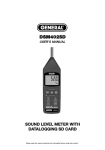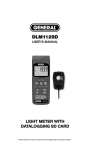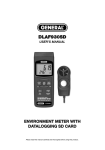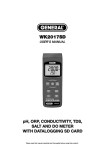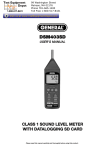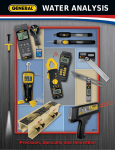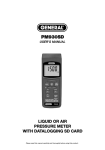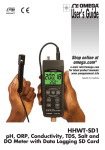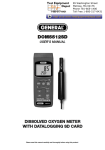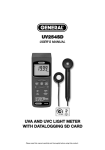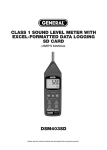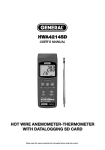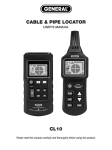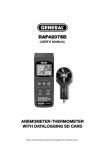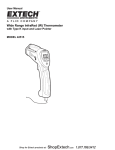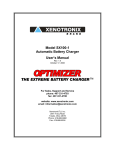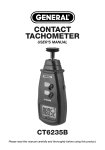Download DPH230SD - General Tools And Instruments
Transcript
DPH230SD USER’S MANUAL pH METER WITH DATALOGGING SD CARD Please read this manual carefully and thoroughly before using this product. TABLE OF CONTENTS Introduction . . . . . . . . . . . . . . . . . . . . . . . . . . . . . . . . . 3 Key Features . . . . . . . . . . . . . . . . . . . . . . . . . . . . . . 3 – 4 Operating Instructions . . . . . . . . . . . . . . . . . . . . . 4 – 12 What’s in the Case . . . . . . . . . . . . . . . . . . . . 4 – 5 Setup . . . . . . . . . . . . . . . . . . . . . . . . . . . . . . . 5 – 7 Calibrating the pH Electrode . . . . . . . . . . . . . 7 – 8 Normal Operation . . . . . . . . . . . . . . . . . . . . . 8 – 9 Holding and Storing Measurements. . . . . . . . . . 9 Automatic vs. Manual Datalogging . . . . . . . . . 10 Transferring Data from an SD Card to a Computer . . . . . . . . . . . . . . . 11 – 12 Specifications . . . . . . . . . . . . . . . . . . . . . . . . . . . . . . 13 Maintenance & Troubleshooting Tips . . . . . . . . . . . . 14 Optional Accessories. . . . . . . . . . . . . . . . . . . . . . . . . 14 Warranty Information . . . . . . . . . . . . . . . . . . . . . . . . 15 Return for Repair Policy . . . . . . . . . . . . . . . . . . . . . . 15 2 INTRODUCTION Thank you for purchasing General Tools & Instruments’ DPH230SD pH Meter with Datalogging SD Card. Please read this user’s manual carefully and thoroughly before using the instrument. The DPH230SD is a general-purpose handheld instrument suitable for measuring the pH and oxidation-reduction potential (ORP) of a solution. Using optional probes with a BNC connector, the meter can measure pH from 0 to 14 and ORP from -1999 mV to +1999 mV. The meter also accepts an optional automatic temperature compensation (ATC) probe that configures the pH electrode to measure solutions whose temperature is between 32º and 150ºF (0º and 65ºC). For measuring the pH of solutions at temperatures between 32º and 212ºF (0º and 100ºC), the temperature compensation can be set manually. pH electrodes must be calibrated for pH 4, pH 7 and pH 10 using buffer solutions. Among the applications and environments suitable for the DPH230SD are water conditioning, wastewater monitoring, beverage production, aquaculture (fish farming), aquariums, pulp and paper processing, electroplating, and photography. The DPH230SD has the performance and features needed to satisfy the most demanding aspects of the above applications. A front-panel pushbutton enables rapid switching between the two measurement modes. Measurement accuracies are ± (0.02 pH units + 2 digits) for pH readings and ± (0.5% of the reading + 2 digits) for ORP readings. Because it is microprocessor-based, the DPH230SD can make full use of the portability, reliability and large storage capacities that SD memory cards offer. Measurements can be made automatically at any sampling rate between one second and nine hours. After timestamping and storing the measurements on an SD card plugged into the instrument (a process called datalogging), the user can remove the card and plug it into a laptop or desktop computer either directly or via a USB card reader. The data logs are stored on the card as files with the .xls extension, which can be opened by Microsoft’s Excel application. The DPH230SD has a backlit 2-1/2 in. diagonal display and is powered by six “AA” Alkaline batteries or an optional 9-VDC AC adapter. KEY FEATURES • Measures pH and ORP using optional electrodes • Measured parameter can be changed by pressing front-panel button • Optional ATC temperature probe automatically calibrates pH electrode to pH 4, pH and pH 10 • Displays maximum and minimum readings • Performs real-time automatic datalogging at sampling time settable from 1 second to 9 hours • Also supports manual logging and changing of card storage location • Outputs Excel-compatible data logs • Accepts SD memory cards of up to 16 GB capacity 3 • Big (2.5 in. diagonal) front-panel green backlit LCD is easy to read • Auto power off function • Powered by six “AA” batteries or optional 9V AC/DC adapter OPERATING INSTRUCTIONS WHAT’S IN THE CASE The DPH230SD comes fully assembled in a carrying case along with a 2 GB SD memory card and this user’s manual. Optional accessories available from General Tools & Instruments include pH electrodes, a probe that enables automatic temperature compensation (ATC) of pH electrodes, an ORP electrode, pH 4 and pH 7 buffer solutions, and a 9VDC adapter for a 110V power supply. See the Optional Accessories section of this manual for more details. Figure 1 shows all of the controls and indicators on the front, back, top, bottom and right side of the DPH230SD. Familiarize yourself with the positions and functions of these controls, indicators and connectors before moving on to the setup procedure. TOP FRONT BOTTOM RIGHT SIDE BACK Fig. 1. The DPH230SD’s controls and indicators and other physical features 4 1-1 Liquid-crystal display 1-2 POWER button 1-3 HOLD/ESC button 1-4 REC/ENTER button 1-5 ▲ button 1-6 ▼ button 1-7 TIME button 1-8 LOGGER SET button 1-9 Kickstand 1-10 Battery compartment cover 1-11 Battery compartment cover screws 1-12 Tripod attachment nut 1-13 Socket for ATC temperature probe 1-14 Socket for pH electrode 1-15 Socket for 9VDC AC adapter 1-16 Reset button 1-17 RS232 output jack 1-18 SD card socket SETUP 1. Choose the power source. Before using the DPH230SD, be sure it is powered by fresh batteries or an optional 9VDC AC adapter plugged into the bottom jack on its right side (callout 1-15). To remove the battery compartment cover, remove the two screws holding it in place (callout 1-11). Then install six “AA” batteries in the correct orientation, using the polarity marks on the inside of the compartment as a guide. Replace the cover by replacing the two screws. 2. Install an SD card. To prepare for setup, also install the supplied 2 GB SD memory card or another card with a capacity from 1 GB to 16 GB in the socket on the bottom of the DPH230SD (callout 1-18). When installing the card, make sure its gold contacts are facing front and push the card into the socket until you hear a click. To remove the card, push it in until you hear a click and the card pops out. Now power on the instrument by pressing the POWER button (callout 1-2) to generate a short beep. (To power off the DPH230SD, press the POWER button and hold it until the instrument responds with a long beep.) When the meter powers on, a series of transient startup screens will briefly appear. Once the display has stabilized, perform the following eight setup steps in the order presented. 3. Format the SD card. LOGGER SET button (callout 1-8) and hold it for at least five seconds, until “Sd-F” appears in the lower half of the display. Quickly (within three seconds) press the REC/ENTER button. (If you press buttons too slowly in setup mode, the screen will revert to the normal display. To return to the setup sequence, press and hold the LOGGER SET button again. To move ahead to the next field in the sequence or to the next parameter, press the HOLD/ESC button.) Pressing the REC/ENTER button causes the word “no” or “yES” to appear over the term “Sd-F”. Press the ▼ button to make a selection. Choose “yES” whenever a new SD card is being used, or when a used card is being repurposed (from use with another SD card instrument or a camera, for example) and all data on it is to be erased. Choose “no” to preserve any data on a card previously used with this instrument. 5 If you choose “yES”, after you press the REC/ENTER button the instrument will prompt you to confirm that decision by displaying the term “Ent” below “yES” and sounding three beeps. To confirm that you want to begin the erasure/formatting procedure, press the REC/ENTER button. “Ent” will then flash several times and the instrument will sound another three beeps to confirm that the SD card has been erased and formatted. 4. Set the date and time. Once the SD card has been formatted (or not), the meter will automatically move to the next step in the startup sequence: setting the current date and time. When the word “dAtE” appears in the center of the display, along with the flashing value “00.00.00” at the lower left, above “yy.mm.dd”, set the current year by pressing the ▼ or ▲ button repeatedly until the correct value appears above “yy”. Press the REC/ENTER button to store the setting. The next screen that appears will have the value above “mm” flashing. Use the ▼ or ▲ button to navigate to the current month and press the REC/ENTER button to store the setting. When the next screen flashes the value above “dd”, again use the ▼ or ▲ button to navigate to the current day and press the REC/ENTER button to store the setting. Once you have set the date, the display will prompt you to set the hour, minute and second of the current time. Again use the or buttons to navigate to the correct values, and the REC/ENTER button to store the settings. 5. Set the datalogging sampling time. Once the date and time have been set and stored, the display will show a value below the letters “SP-t”. Press the ▼ or ▲ button to decrease or increase the flashing hour value until the desired number appears below “SP-t”. Press the REC/ENTER button to store that setting. The minutes value will then flash. Press the ▼ or ▲ button to decrease or increase the value and then press the REC/ENTER button to store that setting. Finally, press the ▼ or ▲ button to decrease or increase the flashing seconds value and then press the REC/ENTER button to store that setting. 6. Enable or disable auto power off. Once the sampling time has been set and stored, the display will show the word “yES’ over the term “PoFF”. Press the ▼ button until the desired automatic power off management scheme (“yES” for enable; “no” for disable) is displayed. Press the REC/ENTER button to store the selection. If enabled, the power off function shuts off the DPH230SD after a period of inactivity of ten minutes. 7. Enable or disable the beeper. Once the auto power off function has been enabled or disabled, the display will show the word “yES” over the word “bEEP”. Press the ▼ button until the desired setting (“yES” or “no”) is displayed, and then press the REC/ENTER button to store the selection. 8. Choose a decimal point or comma to represent the decimal division between integers and fractions (for example, American-style 20.88 vs. European-style 20,88). Once the beeper has been enabled or disabled, the display will show the word “bASIC” above the phrase “dEC”. Press the ▼ button to make “bASIC” (American style) or “Euro” appear in the upper display, as desired. Press the REC/ENTER button to store the selection. 6 9. Select the temperature unit. Once the format of decimal point divisions has been set and stored, the lower portion of the display will show the term “t-CF”. Press either the ▼ or ▲ button to change the letter displayed at the right of the display to “C” (for Celsius units) or “F” (for Fahrenheit units), as desired. Then press the REC/ENTER button to store the selection. 10. Set the compensation temperature for pH electrode measurements when operating without an ATC temperature probe. The default value is 77ºF (25ºC). The value is adjustable between 32º and 212ºF (0º and 100ºC). Once the display temperature unit has been set and stored, the lower portion of the display will show the term “t-SEt”. Press either the ▼ or ▲ button until the value above “t-SEt” matches the desired compensation temperature, in ºC or ºF. Press the REC/ENTER button to store the setting. The display will then either return to the first of the eight steps in the setup sequence— choosing whether or not to format the SD memory card—or show the term “ESC”. If “ESC” appears, press either the HOLD/ESC button or the LOGGER SET button to exit the setup procedure and enter normal operating mode. Fig. 2 CALIBRATING THE pH ELECTRODE The optional pH electrode you are using must be calibrated before making pH measurements with it for the first time. The electrode also should be calibrated whenever you wish to maximize the accuracy of measurements. Calibration is necessary because not every pH electrode is an “ideal” electrode that generates 0 mV at pH 7 and 177.4 mV at pH 4. 1. To calibrate the pH electrode, perform the following procedure while referring to Figure 2. 2. Calibrating a pH electrode using the buffer solution 2-1 Electrode plug 2-2 Electrode handle 2-3 Electrode head 2-4 pH buffer solution 1. Insert the plug of the pH electrode into the BNC socket at the top of the meter (callout 1-14 of Fig. 1). 2. Power on the meter by pressing the POWER button. 3. Using the procedure detailed earlier, manually adjust the compensation temperature so it matches the temperature of the buffer solution. Alternatively, use an ATC temperature probe to make the adjustment automatically. 4. Holding it by its handle, immerse the pH electrode in the bottle of buffer solution. (If you are using the ATC temperature probe, immerse its head in the bottle as well.) 5. Gently shake the electrode (and the probe, if used). The display will show the pH value. 7 6. Use two fingers to press the REC/ENTER and HOLD/ESC buttons at the same time. When this screen appears, release the buttons. 7. Press the ▼ or ▲ button until this screen appears. Press the REC/ENTER button to calibrate the electrode for pH 7. 8. Press the ▼ or ▲ button again until this screen appears. Press the REC/ENTER button to calibrate the electrode for pH 4. 9. Press the ▼ or ▲ button again until this screen appears. Press the REC/ENTER button to calibrate the electrode for pH 10. 10. The pH electrode has now been calibrated once. To maximize measurement accuracy, General recommends rinsing the head of the electrode (and the head of the ATC temperature probe, if used) in distilled water and then repeating the above steps at least twice more. 11. To recalibrate the electrode in the future, you must clear the existing settings. To do so, press the ▼ or ▲ button until this screen appears. Then press the REC/ENTER button to clear the saved settings before repeating the steps above to calibrate the electrode for pH 7, pH 4 and pH 10. NORMAL OPERATION The DPH230SD can measure either the pH or the oxidation-reduction potential (ORP) of a solution. 1. To select the type of measurement, press the ▼ button (which has the word “Function” stenciled above it) until the display shows either the term “pH” or “mV” (the unit of ORP measurements). Following are the default states for the DPH230SD: • pH measurement • Temperature unit of ºC • Manual temperature compensation • Auto power off • Sampling time of 2 seconds To change any of these parameters, use the specific procedure for it detailed in the Setup section. 8 2. To measure the pH of a solution, press the ▼ button until the display shows the term “pH”. Make sure the pH electrode is seated firmly in the BNC socket (callout 1-14 of Fig. 1) on the top of the meter. If the ATC temperature probe is being used, make sure it is seated firmly in its socket (callout 1-13 of Fig. 1) on the top of the meter as well. If the ATC probe is not being used, perform the last step of procedure to manually match the compensation temperature to the temperature of the solution being tested. Holding the pH electrode by its handle, immerse it in the solution under test. (If you are using the ATC temperature probe, immerse its head in the solution as well.) Gently shake the electrode (and probe, if used) to help any air bubbles escape and to ensure an accurate reading. The display will simultaneously show the solution’s pH in the center and either the manually selected compensation temperature or the actual temperature of the solution (as measured by the ATC probe) below it. By default, the temperature reading will be in ºC, unless ºF has been selected. 3. To measure the ORP of a solution, press the ▼ button until the display shows the term “mV”. Plug an optional ORP electrode with a BNC connector into the same socket on the top of the meter (callout 1-14 of Fig. 1) that accepts the plug of a pH electrode. Holding the ORP electrode by its handle, immerse it in the solution under test. Gently shake the head of the electrode to help any air bubbles escape and to ensure an accurate reading. The display will show the ORP of the solution, in mV. Whenever the DPH230SD is in measurement mode, you can turn off the backlight (which is on by default) by briefly pressing (but not holding) the POWER/ESC button. To reactivate the backlight, briefly press the button again. Whenever the instrument is in measurement mode, you also can check the current date and time by briefly pressing the TIME button. Doing so causes both values to appear briefly at the lower left of the display. HOLDING AND STORING MEASUREMENTS 1. To hold a measured value of pH or ORP, press the HOLD/ESC button during the measurement. Doing so will cause the word “HOLD” to appear at the top of the display. Pressing the HOLD/ESC button again releases the hold. 2. To record and recall readings, press the REC/ENTER button while making measurements. This will make the term “REC” appear at the top of the display. Pressing the REC/ENTER button again, briefly, will make the term “MAX” appear to the right of “REC” and switch the display to the maximum value stored in memory during the last recording session. Pressing the REC/ENTER button again, briefly, will make the term “MIN” appear to the right of “REC” and switch the display to the minimum value stored during the last session. 3. To exit recording mode, press and hold the REC/ENTER button for at least three seconds, until the term “REC” disappears from the top line of the display. The display will then revert to showing the current reading. 9 AUTOMATIC VS. MANUAL DATALOGGING The DPH230SD can automatically log data at a user-selected sampling period from 1 second to 9 hours. To view the sampling time for which the instrument was set up, press the LOGGER SET button (which has the words “Sampling check” stenciled below it) once. To change the sampling time, perform Step 5 of the setup procedure. 1. To start automatic datalogging, press the REC/ENTER button once. The top line of the display will show the term “REC”. Pressing the LOGGER SET button at this point will make REC flash and add the flashing term “LOGGER” at the top right of the display. This indicates that the instrument is currently storing measured values and their time stamps in memory. 2. To pause automatic datalogging, press the LOGGER SET button once; this action makes the flashing term LOGGER disappear from the top right of the display and changes the term “REC” from flashing to constant. Pressing the LOGGER SET button again resumes automatic datalogging. 3. To end automatic datalogging, press the REC/ENTER button and hold it for at least two seconds. This action causes the “REC” message to disappear. 4. To log data manually, set the sampling time to zero using Step 5 of the setup procedure. Then press the REC/ENTER button once. The display will show the term “REC” on the top line, a value in the middle, and below it the letter “P” on the left and a number from 1 to 99 on the same line to the right. The number indicates the position on the SD card that will be used to store manually logged data. Now press the LOGGER SET button. This will cause the beeper to sound and the term “LOGGER” to briefly appear at the upper right of the display. As in automatic datalogging mode, in this mode the instrument is storing measurements and their time stamps on the SD card. In manual datalogging mode, however, measurements are being stored continuously (with a sampling time of zero), and their locations on the card can be changed. 5. To change the storage location of manually logged data, press the ▼ button once; this causes the “P” to disappear from the left side of the display and the value on its line to begin flashing. Once the flashing begins, you can use the ▼ and ▲ buttons to change the flashing value to any number between 1 and 99. Once you have chosen the storage location, press the REC/ENTER button to save the setting. This causes the value to stop flashing and the “P” to return. 6. To end manual datalogging, press the REC/ENTER button and hold it for at least three seconds. This action causes the “REC” message to disappear from the top line of the display. 10 TRANSFERRING DATA FROM THE SD CARD TO A COMPUTER After automatic or manual datalogging of measurements, remove the SD card from the meter and plug it into your computer either directly (if it has an SD card slot) or through an SD card reader. Because the files containing time-stamped data logs have the file extension .xls, they open in Microsoft’s Excel application. Figures 3, 4 and 5 show three kinds of Excel presentations: a data-only screen, a graphics-only screen, and a mixed data/graphics screen. Fig. 3. Typical Excel data-only screen 11 Fig. 4. Typical Excel graphics-only screen Fig. 5. Typical Excel mixed data/graphics screen 12 SPECIFICATIONS Embedded microcontroller Custom one-chip LSI device Display type Liquid-crystal with green backlight Display size 2.05 x 1.5 in. (52 x 38mm) Parameters measured pH, ORP Measurement range 0 to 14 for pH; -1999 mV to +1999 mV for ORP Measurement accuracy ± (0.02 pH units + 2 digits) for pH; ± (0.5% of reading + 2 digits) for ORP Measurement resolution 0.01 unit for pH; 1 mV for ORP Temperature compensation Automatic between 32º and 150ºF (0º and 65ºC) when using optional ATC temperature probe; manually settable between 32º and 212ºF (0º and 100ºC) without ATC probe Storable/recallable readings Maximum, minimum Datalogging sampling time Settable between 1 second and 8 hours, 59 minutes, 59 seconds (in automatic datalogging mode) SD card capacity 1 GB to 16 GB Settable parameters Date, time, auto power off, beep sound, sampling time, decimal point or comma decimal division, temperature unit, compensation temperature Operating temperature 32º to 122ºF (0º to 50ºC) Operating relative humidity 0 to 85% Power source 6 Alkaline “AA” batteries or optional 9-VDC AC adapter Power consumption 14 mADC (normal operation, with backlight off and SD card not saving data); 37 mADC with backlight on and card saving data; 49 mADC with backlight on and card saving data Dimensions 6.97 x 2.68 x 1.77 in. (177 x 68 x 45mm) Weight 1.08 lb. (489g) 13 MAINTENANCE & TROUBLESHOOTING TIPS Keep the pH and ORP electrodes and ATC temperature probe clean and protected from the elements when not in use. When the pH electrode is not being used, General recommends keeping its head inserted in the bottle of pH buffer solution. When the icon appears in the left corner of the display, it’s time to replace the six “AA” batteries that power the instrument (although measurements will remain valid for several hours after the low-battery indicator first appears). Replacing the batteries requires removing the two screws that hold the battery compartment cover in place, as explained in Step 1 of the setup procedure on page 5. After inserting fresh batteries in the correct orientation, tighten the screws to secure the cover. If the meter “freezes” (like a computer) and buttons become unresponsive, try resetting the instrument by pushing the RESET button on its right side (callout 1-15 of Fig. 1) with the end of a paper clip. Remove the batteries when storing the meter for an extended period of time. Do not drop or disassemble the meter or immerse it in water. OPTIONAL ACCESSORIES • pH electrodes • ATC temperature probe • pH 4, pH 7 and pH 10 buffer solutions • ORP electrode • 9-VDC adapter for 110VAC power supply 14 WARRANTY INFORMATION General Tools & Instruments’ (General’s) DPH230SD pH Meter with Datalogging SD Card is warranted to the original purchaser to be free from defects in material and workmanship. Subject to certain restrictions, General will repair or replace this instrument if, after examination, the company determines it to be defective in material or workmanship for a period of one year. This warranty does not apply to damages that General determines to be from an attempted repair by non-authorized personnel or misuse, alterations, normal wear and tear, or accidental damage. The defective unit must be returned to General Tools & Instruments or to a General-authorized service center, freight prepaid and insured. Acceptance of the exclusive repair and replacement remedies described herein is a condition of the contract for purchase of this product. In no event shall General be liable for any incidental, special, consequential or punitive damages, or for any cost, attorneys’ fees, expenses, or losses alleged to be a consequence of any damage due to failure of, or defect in any product including, but not limited to, any claims for loss of profits. RETURN FOR REPAIR POLICY Every effort has been made to provide you with a reliable product of superior quality. However, in the event your instrument requires repair, please contact our Customer Service to obtain an RGA (Return Goods Authorization) number before forwarding the unit via prepaid freight to the attention of our Service Center at this address: General Tools & Instruments 80 White Street New York, NY 10013 212-431-6100 Remember to include a copy of your proof of purchase, your return address, and your phone number and/or e-mail address. 15 GENERAL TOOLS & INSTRUMENTS 80 White Street New York, NY 10013-3567 PHONE (212) 431-6100 FAX (212) 431-6499 TOLL FREE (800) 697-8665 e-mail: [email protected] www.generaltools.com DPH230SD User’s Manual Specifications subject to change without notice ©2010 GENERAL TOOLS & INSTRUMENTS NOTICE - WE ARE NOT RESPONSIBLE FOR TYPOGRAPHICAL ERRORS. MAN#DPH230SD 12/07/10
















